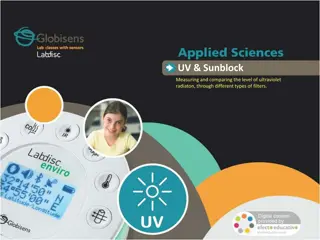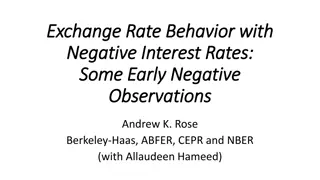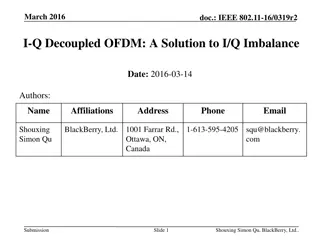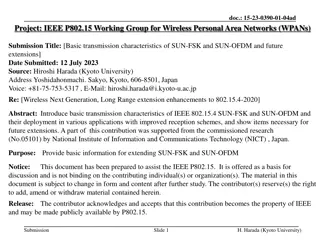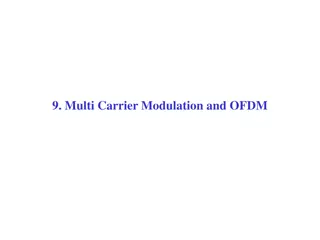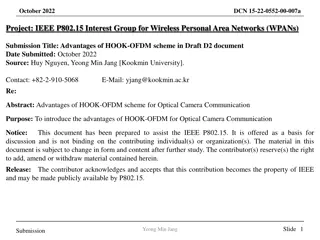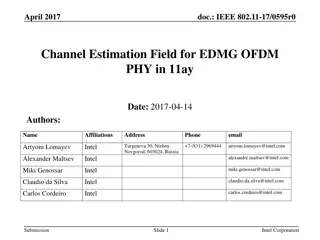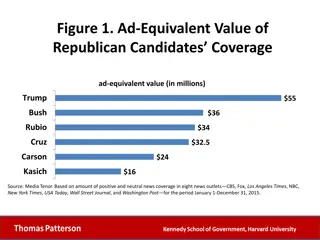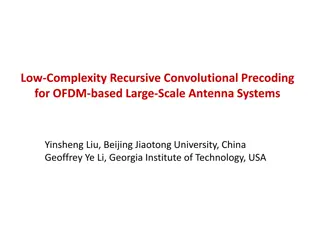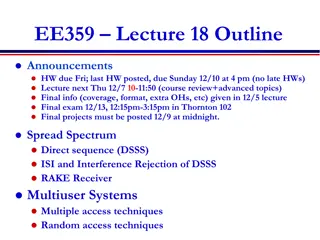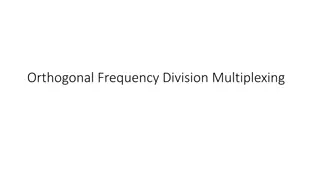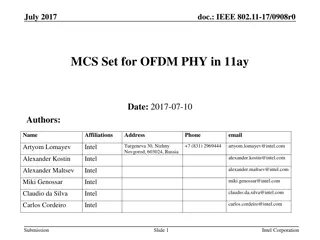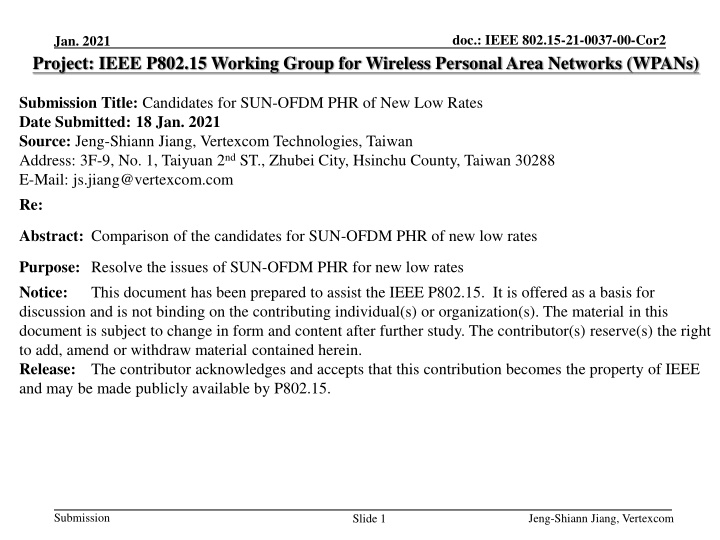
Comparison of Candidates for SUN-OFDM PHR of New Low Rates
Explore the document discussing issues and solutions for SUN-OFDM PHR at low rates. Different candidates and proposals are evaluated for compatibility and effectiveness, aiming to resolve inconsistencies and improve performance in wireless personal area networks.
Uploaded on | 5 Views
Download Presentation

Please find below an Image/Link to download the presentation.
The content on the website is provided AS IS for your information and personal use only. It may not be sold, licensed, or shared on other websites without obtaining consent from the author. If you encounter any issues during the download, it is possible that the publisher has removed the file from their server.
You are allowed to download the files provided on this website for personal or commercial use, subject to the condition that they are used lawfully. All files are the property of their respective owners.
The content on the website is provided AS IS for your information and personal use only. It may not be sold, licensed, or shared on other websites without obtaining consent from the author.
E N D
Presentation Transcript
doc.: IEEE 802.15-21-0037-00-Cor2 Jan. 2021 Project: IEEE P802.15 Working Group for Wireless Personal Area Networks (WPANs) Submission Title: Candidates for SUN-OFDM PHR of New Low Rates Date Submitted: 18 Jan. 2021 Source: Jeng-Shiann Jiang, Vertexcom Technologies, Taiwan Address: 3F-9, No. 1, Taiyuan 2nd ST., Zhubei City, Hsinchu County, Taiwan 30288 E-Mail: js.jiang@vertexcom.com Re: Abstract: Comparison of the candidates for SUN-OFDM PHR of new low rates Purpose: Resolve the issues of SUN-OFDM PHR for new low rates Notice: This document has been prepared to assist the IEEE P802.15. It is offered as a basis for discussion and is not binding on the contributing individual(s) or organization(s). The material in this document is subject to change in form and content after further study. The contributor(s) reserve(s) the right to add, amend or withdraw material contained herein. Release: The contributor acknowledges and accepts that this contribution becomes the property of IEEE and may be made publicly available by P802.15. Submission Jeng-Shiann Jiang, Vertexcom Slide 1
doc.: IEEE 802.15-21-0037-00-Cor2 Jan. 2021 Candidates for SUN-OFDM PHR of New Low Rates Jeng-Shiann Jiang, Vertexcom Submission Jeng-Shiann Jiang, Vertexcom Slide 2
doc.: IEEE 802.15-21-0037-00-Cor2 Jan. 2021 Origin of the Issues Inconsistency between the text and Table 20-9 Backward incompatible with legacy devices (IEEE 802.15.4-2015) MCS independent Inconsistent MCS dependent Submission Jeng-Shiann Jiang, Vertexcom Slide 3
doc.: IEEE 802.15-21-0037-00-Cor2 Jan. 2021 Candidates Candidate 1 15-20-0171: Keep Table. Change Text Candidate 2 15-20-0393: Keep Text. Change Table Candidate 3 15-20-0305: Append PHR2 Candidate 4 15-20-0387: Cancel new low rates. Set aside the issue for further observation, experiment, use case check, and better solution. Leave room for change for future amendment Submission Jeng-Shiann Jiang, Vertexcom Slide 4
doc.: IEEE 802.15-21-0037-00-Cor2 Jan. 2021 More About PHR2 Proposal (1/2) A typical approach used in Wi-Fi 802.11 to guarantee backward compatibility 802.11 802.11g 802.11n: Keep L-SIG, append HT-SIG 802.11n 802.11ac: Keep L-SIG, append VHT-SIG packet length is re-calculated based on 11g MCS0 with 6Mbps PHR2 approach new low rates: Keep PHR, append PHR2 Frame length is re-calculated base on lowest supported rate Backward compatibility: Legacy devices know the packet duration to avoid causing interference and affecting throughput Submission Jeng-Shiann Jiang, Vertexcom Slide 5
doc.: IEEE 802.15-21-0037-00-Cor2 Jan. 2021 More About PHR2 Proposal (2/2) Cons pointed out in 15-21-0029 Higher power consumption Negligible because new low-rate packets only occupy a small portion of all packets. Worthy for the trade-off of backward compatibility Restricted packet length Packet duration is around 0.655 sec for O3M0 2047B, and 1.3 secs for O4M0 2047B. Super long packet is vulnerable to time-varying channels and interferences from legacy devices The restricted packet length is around 330ms, which exceeds the maximum channel dwelling time 250 ms when frequency hopping is used in Wi-SUN. The real concern about this proposal is that the packet format change is now suitable for Corrigendum, but it is suitable for future amendment Submission Jeng-Shiann Jiang, Vertexcom Slide 6
doc.: IEEE 802.15-21-0037-00-Cor2 Jan. 2021 Weighting of the Factors for Decision Making Candidate 1: 15-20-0171: Keep Table. Change Text Candidate 2: 15-20-0393: Keep Text. Change Table Candidate 3: 15-20-0305: Append PHR2 Candidate 4: 15-20-0387: Cancel new low rates Weighting of factors 1. Backward compatibility: can only be sacrificed when Technical errors in previous version (no error in PHR of 802.15.4-2015) Greenfield (assume no legacy devices) 4 = 3 > 2 > 1 2. Performance Better sensitivity with down to 12.5Kbps 3 = 1 > 2 3. Others (simplicity, power consumption, ) Submission Jeng-Shiann Jiang, Vertexcom Slide 7
doc.: IEEE 802.15-21-0037-00-Cor2 Jan. 2021 Our Preference Candidate 1: 15-20-0171: Keep Table. Change Text Candidate 2: 15-20-0393: Keep Text. Change Table Candidate 3: 15-20-0305: Append PHR2 Candidate 4: 15-20-0387: Cancel new low rates Preference Pros Simple Backward compatible Room for future amendment Backward compatible Good sensitivity Good sensitivity 4 > 3 > 2 > 1 Packet format change Backward incompatible Suffer sensitivity Backward incompatible Higher Rx complexity Cons Submission Jeng-Shiann Jiang, Vertexcom Slide 8







